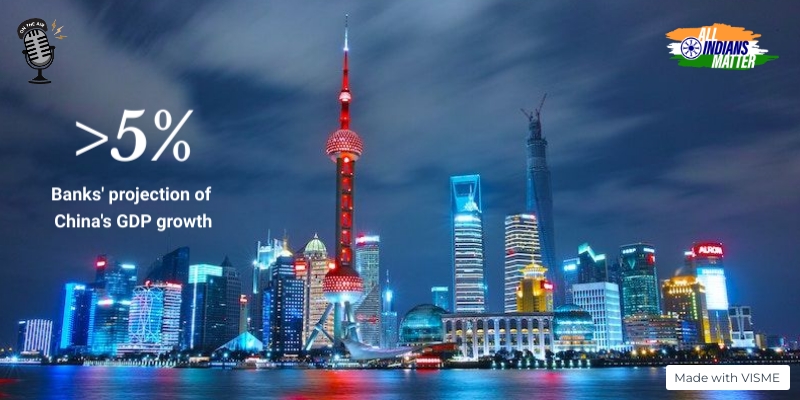Ashraf Engineer
August 26, 2023
EPISODE TRANSCRIPT
Hello and welcome to All Indians Matter. I am Ashraf Engineer.
China has long been the powerhouse of global growth but its economy is slowing now, a fresh worry for not just leaders of governments across the world but also investors. For the longest time, it was China that was the bright spot even as other large economies struggled. This time around, it’s China itself that is the problem. At one stage last week, Hong Kong’s Hang Seng Index had fallen more than 20% from its peak in January and the yuan to its lowest level in 16 years. Why is this happening and, more importantly, what does it mean for India?
SIGNATURE TUNE
After the COVID-19 pandemic, China’s economy was on fire but the momentum is waning. Prices of consumer goods are dipping, exports are retreating and it seems to be in the midst of a real estate crisis. Media reports say that unemployment among the young is so high the government has stopped releasing data about it.
Economists are expressing serious concern about China’s financial stability. The government’s response has been unimpressive, so there’s a new round of rating downgrades in the offing and banks are cutting GDP growth forecasts to below 5%. Among these banks are UBS, Nomura, Morgan Stanley and Barclays.
One of the leading causes of the crisis is the slide of real estate. Among the companies to have defaulted was Country Garden, which used to be China’s largest developer by sales. The government introduced measures to revive the real estate market but even the majors are close to a default.
To make matters worse, debt defaults by developers have spread to the $2.9 trillion investment trust industry. Zhongrong Trust, which managed $87 billion worth of funds for corporate clients and individuals, failed to repay investment products worth $19 million to at least four companies.
Alarmed, domestic funds are choosing safe government bonds and bank deposits now, which means non-banking financial institutions could face liquidity problems.
Government debt is the other worry. The cost of strict lockdowns is finally catching up with local governments, limiting their ability to push growth and offer civic services. Given the debt levels, Beijing’s ability to pump-prime the economy is limited. If it tries, the fear is that government debt would soar to unmanageable levels.
Lastly, there is demographic change. China’s fertility rate, the average number of babies a woman will have over her lifetime, dropped to 1.09 in 2022 from 1.30 in 2021. This places China lower than even Japan, which has been struggling with a greying society for a long time now. A shrinking population presents its own economic challenges. It means a shrinking labour supply and higher spends on healthcare and social spending. This, in turn, means widening fiscal deficits and debt. Which brings us back to real estate – a shrinking population means also that housing demand will fall.
The overall decline in economic growth is likely to last through the medium term at least. Naturally, the jolt to the fastest growing economic system is bad news for global growth. It was China’s management of the pandemic and resumption of economic activity that formed the foundation of the post-pandemic global recovery. How deep will the global impact be of this downturn? Experts seem to be divided.
But how will India be impacted?
First of all, China is a major trading partner of India’s and any slowing of its economy will affect India in some way.
China imports roughly 70% of its iron ore needs from India. A housing industry crisis would mean iron ore exports would shrink for India and negatively impact our economy.
The opportunity for India lies in manufacturing. Industry experts say we could be well on our way to becoming the next big manufacturing destination if we manage things right. This is an opportunity to take back our lost export markets.
Investment in China could reduce because of its slowing economy and be routed instead to India – again, especially in manufacturing. But what’s needed first is significant improvement in ease of doing business, rapid and high-quality infrastructure development, higher literacy, more women in the workforce and a larger skilled workforce. Obviously, none of this is easy or achievable overnight.
The good news is that our technology prowess has given us a start. Already, most global companies have either set up large technology operations in India or rely on India’s IT capabilities and services.
Indian manufacturing is already well known for chemicals, pharmaceuticals, plastics, apparel and other products. What it must try to do is rise up the value chain to medical devices, mobile phones, semiconductors, auto parts, food products, solar panels and more. At the moment, these seem to be the industries in search of new manufacturing locations.
Lastly, there is a shortage of labour in China. India and other South-East Asian countries, meanwhile, have it in abundance. This, too, is a significant advantage.
As China tries to extricate itself from the slowdown, this could be just the moment India was waiting for. The question is, can it capitalise on it?
Thank you all for listening. Please visit allindiansmatter.in for more columns and audio podcasts. You can follow me on Twitter at @AshrafEngineer and @AllIndiansCount. Search for the All Indians Matter page on Facebook. On Instagram, the handle is @AllIndiansMatter. Email me at editor@allindiansmatter.in. Catch you again soon.






